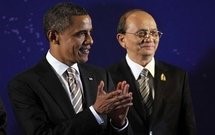 U.S. President Barack Obama hosted Myanmar's president, Thein Sein, at the White House on Monday, the latest sign of a budding relationship between two countries concerned about the rise of China.
U.S. President Barack Obama hosted Myanmar's president, Thein Sein, at the White House on Monday, the latest sign of a budding relationship between two countries concerned about the rise of China.
As recently as four years ago, a bilateral meeting between these two leaders would have seemed an unlikely prospect to many observers of Myanmar's attempts to open up to the rest of the world. Since that time, the United States has rapidly eased sanctions and various other restrictions on relations. It has done so not because Naypyidaw suddenly embraced freedom and undertook irreversible pro-democratic reforms (it has not), but rather because both sides came to view the strategic costs of continued disengagement as unacceptable. At the heart of this change in calculation lies the growth of Chinese power.
Myanmar, formerly Burma, lies on a crossroads between India and Southeast Asia and between China and the Indian Ocean. It consists of a pocket of fertile plains -- the basin of the Irrawaddy River -- enclosed by mountains on every side. Seeking raw materials and markets, the Western colonial powers, initially the Portuguese, attempted to pry open the Burmese core and the surrounding mountain kingdoms from the 16th century onward.
Britain established its dominance during the Anglo-Burmese wars of the 19th century, mostly to gain a buffer for its Indian colonies and expand its economic projects. After Japanese conquest in World War II and subsequent independence from Britain, Burma descended into internal political infighting. Western countries sanctioned the military-run government that emerged from the struggle over human rights abuses and its rejection of outside influence. The country -- newly renamed Myanmar -- turned to China for patronage as Burmese kingdoms had done many times before.
Myanmar's location meant that the British, Japanese and other foreign powers could use it as a backdoor to China. As the dominant outside power, Beijing also adopted this path. In the past decade, the construction of oil and natural gas pipelines from Kyaukphyu to Kunming have served this strategic function, helping reduce China's dependence on the Straits of Malacca.
India, which has long struggled to overcome its own internal distractions to project influence into its jungle-covered eastern periphery, observed this process with trepidation, and the United States and allies like Japan, aware of Beijing's rising power, began looking for ways to hinder Beijing's influence. Myanmar itself grew fearful of China's potential to overwhelm it, not only through investments but also through the manipulation of rebel groups on the border. The country's leadership also observed thriving nearby economies such as Thailand, Malaysia and Singapore that could invest in Myanmar while finding little room to maneuver between its domestic disarray and foreign sanctions.
The need to draw in a wider range of international interests was apparent, but Naypyidaw moved cautiously for fear of losing control and collapsing like so many other post-Cold War regimes. The government officially launched a reform roadmap in 2003, aiming for a "democratic" self-reinvention that would rotate some military leaders into civilian positions while retaining the military's power at the core. The new system would maintain political consolidation and meet the minimum U.S. and European requirements for removing sanctions and allowing foreign investors into the country. The 2010 elections marked one of the more visible milestones of this process, but the more telling fact is that, with a few gestures toward a less oppressive security apparatus, the government has both retained control and persuaded the Western powers of sufficient compromise, clearing the way for the recent flood of foreign investment.
Myanmar is now engaged in a much more active and potentially dangerous game of balancing. It is courting more robust economic and strategic relationships with the United States, as well as India and the Association of Southeast Asian Nations, as options to hedge against China. But Beijing is aware of the threat to its border areas and envisioned energy corridor. It retains extensive influence within the government and the ethnic minority rebel groups, and knows how to exploit the lack of unity among the western and rival Asian powers. Namely it knows that Myanmar and its neighbors want the economic benefits of both Chinese and Western engagement without favoring American interests to the point that they embroil themselves in a conflict with China.
For Washington, re-engaging with Myanmar is a low-cost way of challenging Beijing and expanding economic opportunities. It also serves as a gateway to broadening U.S. relations with the Association of Southeast Asian Nations as a block, so that they can someday pursue their interests collectively in dealing with China or any other regional players that could threaten to dominate the area. But Naypyidaw knows from history that juggling the interests of outsiders can lead to disastrous consequences. Therefore, even as its leaders strive to create options outside China's control, they must preserve the avenues for retreat from the new internationalism, or at least ways of appeasing Beijing, and this will impose limits on Washington's plans.
Courtesy : Stratfor (www.stratfor.com)